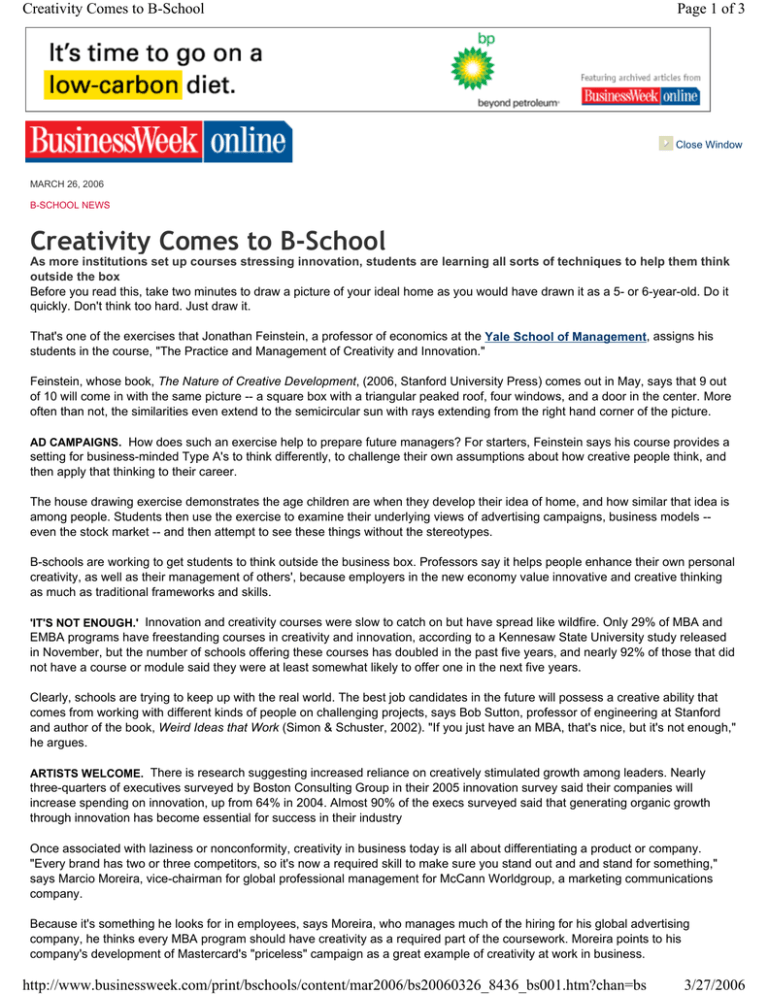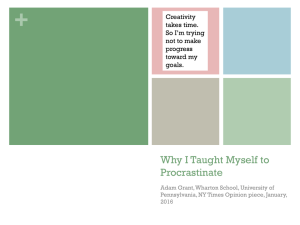Creativity Comes to B-School Page 1 of 3
advertisement

Creativity Comes to B-School Page 1 of 3 Close Window MARCH 26, 2006 B-SCHOOL NEWS Creativity Comes to B-School As more institutions set up courses stressing innovation, students are learning all sorts of techniques to help them think outside the box Before you read this, take two minutes to draw a picture of your ideal home as you would have drawn it as a 5- or 6-year-old. Do it quickly. Don't think too hard. Just draw it. That's one of the exercises that Jonathan Feinstein, a professor of economics at the Yale School of Management, assigns his students in the course, "The Practice and Management of Creativity and Innovation." Feinstein, whose book, The Nature of Creative Development, (2006, Stanford University Press) comes out in May, says that 9 out of 10 will come in with the same picture -- a square box with a triangular peaked roof, four windows, and a door in the center. More often than not, the similarities even extend to the semicircular sun with rays extending from the right hand corner of the picture. AD CAMPAIGNS. How does such an exercise help to prepare future managers? For starters, Feinstein says his course provides a setting for business-minded Type A's to think differently, to challenge their own assumptions about how creative people think, and then apply that thinking to their career. The house drawing exercise demonstrates the age children are when they develop their idea of home, and how similar that idea is among people. Students then use the exercise to examine their underlying views of advertising campaigns, business models -even the stock market -- and then attempt to see these things without the stereotypes. B-schools are working to get students to think outside the business box. Professors say it helps people enhance their own personal creativity, as well as their management of others', because employers in the new economy value innovative and creative thinking as much as traditional frameworks and skills. 'IT'S NOT ENOUGH.' Innovation and creativity courses were slow to catch on but have spread like wildfire. Only 29% of MBA and EMBA programs have freestanding courses in creativity and innovation, according to a Kennesaw State University study released in November, but the number of schools offering these courses has doubled in the past five years, and nearly 92% of those that did not have a course or module said they were at least somewhat likely to offer one in the next five years. Clearly, schools are trying to keep up with the real world. The best job candidates in the future will possess a creative ability that comes from working with different kinds of people on challenging projects, says Bob Sutton, professor of engineering at Stanford and author of the book, Weird Ideas that Work (Simon & Schuster, 2002). "If you just have an MBA, that's nice, but it's not enough," he argues. ARTISTS WELCOME. There is research suggesting increased reliance on creatively stimulated growth among leaders. Nearly three-quarters of executives surveyed by Boston Consulting Group in their 2005 innovation survey said their companies will increase spending on innovation, up from 64% in 2004. Almost 90% of the execs surveyed said that generating organic growth through innovation has become essential for success in their industry Once associated with laziness or nonconformity, creativity in business today is all about differentiating a product or company. "Every brand has two or three competitors, so it's now a required skill to make sure you stand out and and stand for something," says Marcio Moreira, vice-chairman for global professional management for McCann Worldgroup, a marketing communications company. Because it's something he looks for in employees, says Moreira, who manages much of the hiring for his global advertising company, he thinks every MBA program should have creativity as a required part of the coursework. Moreira points to his company's development of Mastercard's "priceless" campaign as a great example of creativity at work in business. http://www.businessweek.com/print/bschools/content/mar2006/bs20060326_8436_bs001.htm?chan=bs 3/27/2006 Creativity Comes to B-School Page 2 of 3 INNER INVENTOR. But not everyone is convinced that innovation should be a focus for MBAs. Mastery of other skills, especially leadership, ethics, and business fundamentals such as finance and accounting, should come before creativity, says Ed Conlon, associate dean for graduate programs at the Mendoza Collegeof Business at Notre Dame University. "The first task in wanting to be creative is to really understand the problem, knowing all the fundamental ways to approach it," he says. "If you don't understand what's inside the box, then you really aren't prepared to think outside it." Still, others say that these courses are one way that schools can better prepare students for the ever-changing work environment. Different professors approach the subject of creativity in different ways. GAME GURU. At Yale, Feinstein uses historical figures and life stories to shed light on the creative process that contributed to such groundbreaking research as Einstein's theory of relativity. Feinstein teaches students about authors like Virginia Woolf and William Faulkner, as well as artist Alexander Calder, to demonstrate that the creative process is just that -- a process just as accessible to them as to anyone else. Instead of examining historical figures, marketing Professor Yoram Wind from the Wharton School at the University of Pennsylvania , turns to today's creative leaders -- from architects Bob Venturi and Denise Scott Brown to game designer and Sony Online Entertainment CCO Raph Koster. Hearing from such impressive speakers reinforces the importance of the unstructured problems that all managers face. "When we look at leaders, they all have a high level of tolerance for ambiguity," says Nina Godiwala, a second-year student in the course. "A lot of MBA students are not very good at that." COMIC BOOKS. Sometimes, students need to get outside the classroom to think outside the box. B-school students in Professor Jim Patell's "Entrepreneurial Design for Extreme Affordability" course at Stanford head to places like Burma to examine farming and irrigation methods in rural areas. Business students are put in teams with engineers, designers, education students, computer scientists, even literature students, to confront a major problem in the developing world. Then they design and build working prototypes to attempt to correct it. Patell says the most important component of the course is learning that it's O.K. to fail. "If you don't get something the first nine times, then you're encouraged to get it on the tenth, because this is school," he says. "We're not expected to solve these problems." Learning to see things from different perspectives often requires interacting with a mix of people. On Mar. 21, MIT Sloan School of Business and the School of the Museum of Fine Arts in Boston (SMFA) hosted "Twenty-First Century Visual Arts for Business Leaders," an intensive, one-day workshop that paired 12 Sloan students with master of fine arts students from the museum school.There were three components: digital animation, digital comic book storyboarding, and color. STRANGE BEDFELLOWS. As if drawing a cartoon storyboard wasn't different enough, MFA students gave the B-schoolers a twist. Students were divided into teams of two. Starting at opposite ends of the storyboard, one team drew the first panel and the other drew the last without looking at what the others had done. Each time they completed a box, the teams switched positions, so that they never got to draw two pictures in a row. The challenge was to create a coherent narrative that worked from beginning to end while escaping their linear thinking patterns. "My team drew a yogi meditating on a mountain, and the other team drew a bunch of fish jumping out of an airplane," says Corey Halverson, a second-year student at Sloan. "We needed to think hard about how to connect those two panels." Halverson says he will use lessons from the day's workshop in his future career in television media. As companies seek more innovative employees, MBAs who have learned techniques for cutting-edge creative thinking might have an edge in the new economy. Gangemi is a reporter with BusinessWeek Online in New York Edited by Phil Mintz Advertising | Special Sections | MarketPlace | Knowledge Centers Terms of Use | Privacy Notice | Ethics Code | Contact Us http://www.businessweek.com/print/bschools/content/mar2006/bs20060326_8436_bs001.htm?chan=bs 3/27/2006 Creativity Comes to B-School Page 3 of 3 Copyright 2000- 2006 by The McGraw-Hill Companies Inc. All rights reserved. http://www.businessweek.com/print/bschools/content/mar2006/bs20060326_8436_bs001.htm?chan=bs 3/27/2006






